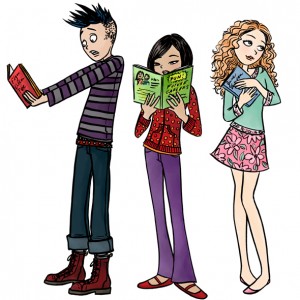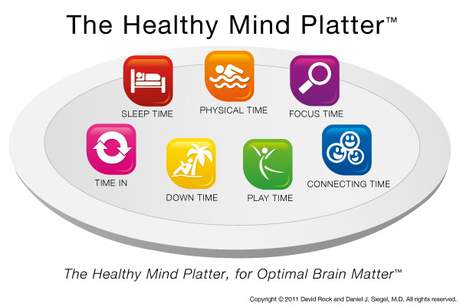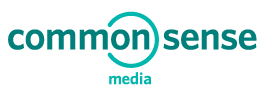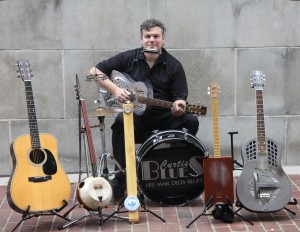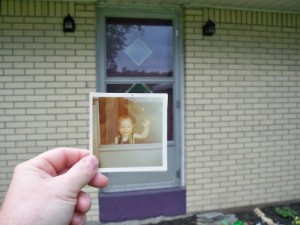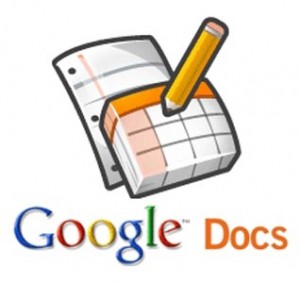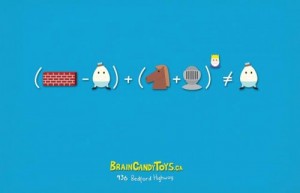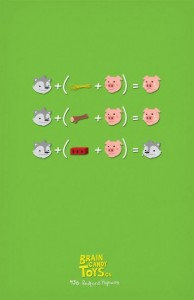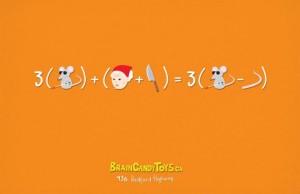June 1, 2011: Day 1
Web of One, or Web of All?
I saw this posted on twitter and have seen it on the front of Ted, but I haven’t gotten around to watching it. This video is what sparked me to document my learning this summer. What I Learned:
- customization of the web is isolating people in their own filter bubbles
- we need to teach students about this invisible bubble and how to expand our information to include things that are not familiar and uncomfortable
- the Internet is not truly “open”
My Learning Path:
- I shared this with two colleagues at my school.
- I had a conversation with one of the colleagues about why it is vital to teach media literacy in school.
Further Learning:
- I preordered Renee Hobbs’ new book Digital and Media Literacy: Connecting Culture and Classroom
- In working with designing a new spiraling technology curriculum, I will look into resources from Temple’s Media Lab and Common Sense Media
June 2, 2011: Day 2
Storytelling Comes to Life Digitally
What I Learned:
- The power of feeling like you belong to something big is strong
- People appreciate when others put big ideas into action
- Storytelling is still our strongest form of communication
My Learning Path:
- I found this on twitter and quickly shared this with my #encghat tweeps
- I began to think about the implications for my classroom
- How could I get my students to experience the feelings of those in the video when they were included in the story?
Further Learning:
- Check out the facebook page from the video
- Consider having students write 150 word short, short stories
- Use twitter to have students write a collaborative short story
- Connect kids to a google doc around campus to write the stories they see in front of them
June 3, 2011: Day 3
Ostracism: Bullying doesn’t just happen to kids
Ostracism is a form of bullying for students and adults. I had two interesting connections about ostracism and bullying today. One was an email from Facing History and Ourselves about a new program based on a case study for use with middle school students called Bullying: A Case Study in Ostracism. The other was a post in my Google Reader by Chris Wejr on the Connected Principals Blog called When Adults are the bullies.
What I Learned:
- Facing History continues to be an outstanding organization focused on tolerance and acceptance
- Ostracism is a problem for both students and teachers
- Not only do students pick on the high achieving students, but teachers pick on the high achieving teachers
- Ostracism is a form of bullying that is not easily recognized because it is an emotional form of abuse instead of a physical form
My Learning Path:
- I sent the Facing History article to a colleague since we have been discussing ways to handle bullying and relational aggression in our middle school
- I reflected upon the times I’ve seen ostracism of teachers in every building I’ve taught at
- I re-tweeted Chris Wejr’s post and have others retweet that already…people need to see ostracism is a problem in schools…awareness is the first step
Further Learning:
- Contact Facing History and Ourselves to see if they will do a workshop at my school
- I’ve read The Curse of the Good Girl but would like to find more books on relational aggression and bullying…explore boy bullying books as well
- Find ways to help students realize that ostracism is a form of bullying…complete the online workshop from Facing History and Ourselves
June 4, 2011: Day 4
Where are you online?
See video here
“What’s Your Story?” is an international video contest held by Trend Micro that empowers youth to be leaders in educating others about being safe online. This powerful video by two young filmmakers in Ohio won with their form of what I refer to as spoken poetry.
What I Learned:
- spoken / visual poetry is very effective in getting a message across to kids
- Trend Micro has an internet safety site for kids
- “Where Are You?” online is a good question to pose to both students and adults
My Learning Path:
- Rich Kiker posted the link on twitter
- I watched the video and immediately retweeted it
- I felt compelled to add this to the big thing I learned today even though it is only 8 in the morning…it was that compelling. It could be that it made a connection in my mind to what I learned about bullying/ostracism yesterday.
Further Learning:
- Investigate the internet safety for kids site to see if there are things I can use in the classroom or in the school-wide curriculum
- Spend some time viewing all the winners from Trend Micro’s “What’s Your Story?”
- Check out Temple’s Media Lab and Commonsense Media for ways to incorporate purposeful and meaningful lessons about online bullying, keeping a digital footprint positive, and the implications and benefits to life online.
- Find out how to get students involved in next year’s Trend Micro internet safety video contest
June 5, 2011: Day 5
Boys learn differently.
Last night, I was watching Radio Flyer with my daughter and two sons. In the trailer link above, you’ll see the 7 secrets of childhood for boys. As I was watching the movie, I couldn’t help notice that my boys were responding to the relationship with their dog and the building of the radio flyer plane, whereas my daughter and I were having an emotional response to the abusive nature of the stepfather. This was a great visual and reminder that not only do boys and girls learn differently, they respond to emotional situations differently. What I Learned:
- The 7 secrets of being a kid that are lost between the ages of 12-13 (see trailer clip)
- Boys love to actively use their imaginations in play, building, and relationships
- Dogs truly are a boy’s best friend
- Kids don’t play outside and explore like they used to
- Girls gravitate to the emotional response
- It’s great to watch an older movie with your own kids
- Tom Hanks was talking about big ideas before any of us were
My Learning Path:
- My middle son was browsing the free movies and asked if I’ve ever seen Radio Flyer…I hadn’t, so we watched it
- As I was watching the movie, I couldn’t help think about the learning and responding implications in the classroom
- I’ve been thinking a lot about how boys learn in the classroom and have been reading Boy Writers and The Trouble With Boys
- I began thinking about the assignments…especially in language arts…I give. We ask boys to do a lot of reflection and emotional responding
- I have also been reading New Culture of Learning: Cultivating the Imagination in a World of Constant Change, which has great implications of the idea of innovation and play in the classroom
Further Learning:
- Examine the balance I have in my classroom between emotional and reflective response to playful and imaginative response
- When designing projects, look for opportunities to incorporate the digital or physical building of an idea or response
- Get my kids to play and create more…outside
- Encourage students to find those big ideas and make a plan for it…make room for these discoveries in the classroom
- Continue to research how boys learn differently in the classroom
June 6, 2011: Day 6
#YAsaves
Yesterday, I was doing my regular Sunday morning twitter scroll through when I saw people posting the now infamous Wall Street Journal article about young adult literature being too dark. Immediately following, I began to notice the #YAsaves hashtag bombarding my twitter stream. I spent the next few hours reading, connecting with YA authors and readers, and investigating some of the titles mentioned in the article and on Twitter.
What I Learned:
- The WSJ article highlighted one mom in one bookstore and caused one big explosion in social media
- People are very passionate about YA lit…there isn’t any real inbetween
- I believe YA lit creates a space where teens can be embraced, understood, and allowed to be their authentic selves
- YA lit authors understand teens like no one else
- Twitter is a powerful medium to connect people with a common cause
My Learning Path:
- I first saw the WSJ article on twitter, then noticed the #YAsaves hashtag
- I participated in the twitter discussion and sent the article to a colleauge
- I opened an amazon tab and a goodreads tab and began to add the books in question to my “to read” list
- I noticed a trend on goodreads of people adding YA lit books
Further Learning:
- Continue to monitor the #YAsaves tag and blogs that are currently being written about YA lit
- Start reading Shine and Scars
- Continue to be an advocate for YA lit
- Have a conversation with my language arts department about their reactions to “darkness” in YA lit and what they think is appropriate for middle school
- Figure out how to balance what kids are interested in reading and the novels we choose as a department
- Examine our independent reading list and compare it to what students are reading outside of school…look for patterns of interest
- Talk to students about what they think is appropriate for the classroom versus outside the classroom…is there a difference?
June 7, 2011: Day 7
Assessing Culture: Who am I? Assessing My Culture
I received an email from Teaching Tolerance today with the subject “The Unknown Anne Frank”. After just finishing my Holocaust Studies in 7th grade last week, I was interested to see what they had to offer. When I opened the email, the second link was the one that drew me in called Assessing My Culture: Who am I? The presentation is based around culture and its implications in the classroom. It is designed as the first in a three part professional development series from the organization. The slideshow has audio and can be easily used in small groups and is created to spark discussion amongst colleagues. The presentation can be found in the link above.
What I Learned:
- “Change begins from deep inside a system, when a few people notice something they will no longer tolerate, or respond to a dream of what’s possible. We just have to find a few others who care about the same thing. Together we will figure out what our first step is, then the next, then the next. Gradually, we become large and powerful. We don’t have to start with power, only with passion.” Margaret Wheatley
- Culture is a combination of thoughts, feelings, beliefs, values, and behavior patterns that are shared by racial, ethnic, religious, social, or organizational groups.
- Culture is the filter that helps us make sense of the most ordinary things.
- Big C culture: race, ethnicity, gender, groups developing a common identity
- Little C culture: individual culture identity, not tied to any specific group, honors the complexity in each of us
- Teachers need to be aware of personal culture, culture of students, and the culture of the school
- Cultural Competence: moving beyond tolerance and acceptance, respecting differences
- Cultural Proficiency: a culturally proficient educator becomes willing to make adjustments
My Learning Path:
- By signing up for Teaching Tolerance’s newsletter a year ago, I was notified about their new professional development series on culture
- My interest in Anne Frank made me open the email
- As soon as I began the presentation, I was taking notes and thinking about ways to use it in school
- While looking up Margaret Wheatley, I found myself reading an edutopia article called Educational Change Starts With Listening
Further Learning:
- Continue to follow the other two parts in the series when they become available
- Read the edutopia article
- Add Turning to One Another: Simple Conversations to Restore Hope to the Future to my “to read” list
- Consider using the series as part of my school’s professional development work
- Share this presentation with administrators at my school
June 8, 2011: Day 8
Leading with Lollipops
What I Learned:
- Lollipop moments are those moments we feel strongly about, but don’t necessarily tell the person responsible for that moment
- We need to redefine leadership so it isn’t about power, but something that is achievable daily
- We need to be aware of how many lollipop moments we create, acknowledge, pay forward, and say thank you for
- Begin to change one person’s understanding of the world by showing them what they are capable of, that we care about them, and they are a powerful agent of change
- Drew Dudley is an amazing leader and speaker
My Learning Path:
- Think_teach tweeted this morning that he booked Drew Dudley to start off his school year in September about the building capacity for different types of leadership
- I googled him and found his TedxToronto video on youtube
- I began scribbling notes about leadership…it is important that all teachers know they are leaders…we need to point those moments out to them
Further Learning:
- Subscribe to Drew Dudley’s youtube channel
- Watch the other TedxToronto speakers
- Share this video with leaders in my school
- Begin talking about redefining leadership
June 9, 2011: Day 9
Using Technology to Move Beyond Schools
I came across this article in my Google Reader today from The 21st Century Fluency Project. If you don’t already subscribe to their RSS, I highly recommend it.
What I Learned:
- Many students are stifled during the school day by technology policies…they leave the building each day to a world that is connected
- “When students step out the door of the institution called school today, they step into a learning environment that is organized in ways radically different from how it once was. It’s a world in which access to knowledge is relatively easy and seamless; in which one is free to follow a line of inquiry wherever it takes one, without the direction and control of someone called a teacher; and, in which, with a little practice, most people can quickly build a network of learners around just about any body of knowledge and interests, unconstrained by the limits of geography, institutions, and time zones.”
- Three possible school scenarios: “fighting for survival”, “controlled engagement”, “open access to learning”
My Learning Path:
- Two years ago, I attended a conference by Ian Jukes
- I began following him on The Committed Sardine
- The blog expanded into The 21st Century Fluency Project
- As I was reading the article, I was reminded of a talk I saw Chris Lehmann give on youtube in which he gave a description of students leaving school and grabbing for their electronic devices…it was like they were searching for oxygen
Further Learning:
- Consider the questions the authors leave us with at the end of the article:
- Talk with students, teachers, and other educators about what school could and should look like. Encourage them to be audaciously imaginative.
- Visit (in person or virtually) schools that look really different.
- Use new school construction and renovation conversations as opportunities to think differently about the design of learning environments.
- Read the series of articles about ed reform on Education Week
June 10, 2011: Day 10
Book Trailers Bring Books to Life
One of my favorite blogs in my Google Reader is Reading Vacation by Melina…a tween girl who blogs about the books she reads. Today she posted a book review, which contained a book trailer for Miss Peregrine’s Home for Peculiar Children. I’ve been quite interested in this book, so I was glad Melina reviewed it today. The thing that got me thinking today was the book trailer that was inserted at the end of her review, which can be viewed above.
What I Learned:
- Book trailers create emotional and visual interest in books
- In the high tech, entertainment driven world we live in, using theatrical book trailers in the classroom will spark more interest in reading
- A tween girl can take her passion for reading and create a space for herself to share it with the world
- On that note…I reminded myself to encourage students in my classroom to write about what they love to write about
My Learning Path:
- I found Melina on twitter last summer and added her to my Google Reader
- I look forward to her reviews and find myself reading every one she posts
- I began to think about how book trailers can be used to create interest in reading in the classroom
- I’ve never had my students make book trailers, but I think I might now..
Further Learning:
- Read Miss Peregrine’s Home for Peculiar Children
- Investigate book trailers for novels I currently use in class
- Begin to plan a book trailer project…link it with things I’m doing on Google Docs and Google Sites…maybe a collaborative project?
- Continue to support Melina in her fantastic blogging adventures!
June 11, 2011: Day 11
Standardized Testing: The Good, the Bad, the Ugly
I took my PRAXIS test for Educational Leadership: Administration and Supervision today. I haven’t taken a standardized test in 17 years, and I’m really thankful for that. I came out of that test today with some strong feelings about the way we are testing our students, and the policy makers and government agencies enforcing these practices. I came home from the test completely spent and fell asleep for 2 hours. I was completely prepared for the test, but the amount of time, stress, and high stakes aspect of the testing fried my brain. What I Learned:
- Standardized testing is exhausting
- The test did not reflect what I learned in my 200+ hours of internship work I did for 2 years
- I don’t believe the 95 questions reflects my ability to be a leader
- My husband had me ask him some of the questions in the practice test last night…he’s not an educator…he got them all right
- The test measures my ability to be a good multiple choice test taker…not be a great principal
- Tremendous empathy for students taking days upon days of standardized testing
My Learning Path:
- I finished my test about 30 minutes early…I was not allowed to do anything but sit there, so I sat there and really thought about the process I just went through
- I imagined being 9 years old and in 3rd grade taking PSSA’s every day for a week…plus having to keep it together for the rest of the day in other subject areas
- I asked myself if this type of testing situation was truly measuring my knowledge or my ability to take a multiple choice test
- We are putting so much into what testing results say…there has to be a better way to show authentic learning….isn’t it worth the time and effort to create rubrics and criteria for authentic assessment instead of running the standardized bubbles through a machine?
- I think all adults involved in education…teachers to policy makers…should have to sit and take a standardized test. Sometimes we need to remember what we are doing to our children.
- I’m so happy I teach at an Independent School where standardized testing doesn’t govern teaching or learning!
Further Learning:
- Investigate some of the recent articles about parents opting out of standardized testing
- Continue to offer authentic assessments that show growth and learning over time
- Revisit the Finland Phenomenon and how they are so successful in education without high stakes testing. Check out this blog post about it.
June 12, 2011: Day 12
3 P’s Grading System: Participation, Progress, Performance
A few weeks ago during #engchat on twitter about discussion in the classroom, Glenda Funk mentioned that she used the 3 P’s grading system. It isn’t anything I’ve ever heard of, but I quickly bookmarked it to check it out later. It wasn’t until her blog post came through my Google Reader today that I remembered that I wanted to look further into it. The 3 P’s grading system by Steve Peha can be located as a download on the left-hand side of this site. What I Learned:
- The 3P method puts the responsibility of grading equally on the student and the teacher
- Participation = 50% of the student’s grade.
- Progress = 30% of the student’s grade
- Performance = 20% of the student’s grade.
- This system allows for more accountability for preparation on the student’s part
- It is ideal for the Language Arts classroom
- 3P allows for reflection by the student regarding their grade…I love this because students are always right on with their self evaluations
My Learning Path:
- I was first introduced to 3P on #engchat
- I added Glenda’s blog to my Google Reader…amazing how much I learn from my Google Reader every day!!!
- I downloaded the complete guide that Glenda linked to for thorough reading
- I really like thinking about grading differently…this might be something that will work nicely for me and my students
Further Learning:
- Read Steve Peha’s 3 P Grading System: An easier, faster, better way to evaluate students and their work
- Check out A Repair Kit for Grading by Ken O’Connor
- Read the accompanying powerpoint to 15 Fixes for Broken Grades
- Reflect on the no zero policy mentioned in Glenda’s post along with what I’ve read in Rethinking Homework
June 13, 2011: Day 13
Hogwarts and the Future of Education
I didn’t realize I had this little gem of a link sitting in my @ messages in twitter until this morning! Garth Nichols sent it to me 5 days ago, but between changing phones and computers, it got lost on me. So, I’ve chosen this TEDx talk by Garth for what I’ve learned today…even though it is only 7 in the morning…I don’t think anything is going to top this today!
What I Learned:
- School in Harry Potter at Hogwarts is real life
- “The Prophet” (newspaper in Harry Potter) is the future of the textbook: dynamic, current, ever changing and moving
- Future textbook will be authentic and authoritative because everyone will contribute to it
- Teachers at Hogwarts don’t teach to the test…they learn through authentic experiences with each other
- Teachers are out there doing things…then bring it back to the classroom to learn and share
- Teachers are collaborators with the students
- Future courses will be problem based
- Allow students to find their passions, find their voice, and fulfill their destiny
My Learning Path:
- About 5 days ago, I saw Garth tweet about Lollipop Leadership by Drew Dudley
- You can read my account on my Day 8 post above
- Garth and I had an exchange on twitter about Drew and TEDxToronto …he sent me his TEDx talk, but I didn’t see it until today!
- I watched the talk and was blown away by the simple, yet brilliant metaphor of Hogwarts and the Future of Education
- It made me begin to think about what we can do now to add authentic and problem based learning into the classroom
- It allowed me to think differently about what a textbook is as a curriculum coordinator
Further Learning:
- Share this talk with admin
- Begin to have a conversation about what learning can really look like
- Investigate opportunities to use open source, collaborative text books…I’m particularly interested in flexbooks for science
- Continue to incorporate digital essays (wikipedia type pages) into my Language Arts classroom to create collaborate learning spaces
- Make sure to check @ messages daily! Thanks Garth!
June 14, 2011: Day 14
Faculty Meetings in Real Time
I had this Edutopia article bookmarked to read, and just got a chance to tonight.
What I Learned:
- A faculty meeting is usually a very basic transfer of information
- Audience engagement, processing, conversation, interaction, and collaboration — all the valuable elements of learning are missing from these meetings
- Schools must stop simply meeting and start connecting and sharing, and encourage transparent learning.
- Use Google Docs for impromptu collaborations
- Can be used for summer work
- Provides a rich learning environment without the constraints of time and space
My Learning Path:
- I saw this article tweeted and in my Google Reader, so I bookmarked it in Diigo
- In my new position, I’m responsible for faculty meetings, so I had a high interest level
- I like the idea of having the meeting be impromptu because you don’t have to wait until the next faculty meeting to discuss something
- Fantastic that coaches won’t miss meetings
Further Learning:
- Experiment with this format for summer work
- Since my school is officially running on a Google Platform, this will be an easy implementation…just make sure everyone is comfortable within Google Docs
- Use this format during opening meetings
June 15, 2011: Day 15
In Homework Revolt, Schools Cut Back
What I Learned:
- “Race to Nowhere” has pushed schools to rethink homework
- There are huge inconsistencies within grade levels at the same school regarding homework
- Homework continues to be values based…parents assume what was good for them is good for their children
- There is no proof that homework improves performance
- People confuse homework with rigor
- Homework should be meaningful and manageable
My Learning Path:
- This came through my Google Reader and I also saw Will Richardson tweet about it
- I became interested in homework research last year in my graduate coursework
- Rethinking Homework continues to be my go to source on thinking about homework differently
- Five Hallmarks to good homework should be shared at my school
Further Learning:
- Consider using Rethinking Homework or Five Hallmarks as a discussion springboard in faculty meetings next year
- Examine Cathy Vatterott’s website: The Homework Lady
- Read The Homework Myth
- Go see “Race to Nowhere”
June 16, 2011: Day 16
Healthy Mind Platter
What I Learned:
- We are entertaining an epidemic of “overwhelm”
- Mental well-being is being stretched through multi-tasking, fragmented attention and information overload
- Platter has seven essential mental activities necessary for optimum mental health in daily life
Focus Time. When we closely focus on tasks in a goal-oriented way, taking on challenges that make deep connections in the brain.
Play Time. When we allow ourselves to be spontaneous or creative, playfully enjoying novel experiences, which helps make new connections in the brain.
Connecting Time. When we connect with other people, ideally in person, or take time to appreciate our connection to the natural world around us, richly activating the brain’s relational circuitry.
Physical Time. When we move our bodies, aerobically if possible, which strengthens the brain in many ways.
Time In. When we quietly reflect internally, focusing on sensations, images, feelings and thoughts, helping to better integrate the brain.
Down Time. When we are non-focused, without any specific goal, and let our mind wander or simply relax, which helps our brain recharge.
Sleep Time. When we give the brain the rest it needs to consolidate learning and recover from the experiences of the day.
My Learning Path:
- Sir Ken Robinson tweeted this article from Psychology Today
- Being a visual person, the image of the healthy mind platter drew me in to read the entire article
Further Learning:
- Try to remember this platter to balance my “always on” lifestyle
- Follow David Rock and Dan Siegel
- Attempt to map out a day or a few days according to the healthy mind platter to see where I am and what I need to work on
June 17, 2011: Day 17
CommonSense Media is a Valuable Resource for Teachers and Parents
If you haven’t been checking books and movies for your children and students at commonsense media, you should. I got an email today from a friend who saw Super 8. She had noted that is was really scary in some parts, so it might not be appropriate for my younger son. She said said commonsense media had rated it PG-13 even though it is being hyped as the big family movie of the summer…the ET of 2012. I’ve been using commonsense media for some time now, but sometimes it is nice to reminded about the value of something you’ve learned.
What I Learned:
- To check movie ratings on commmonsense media before taking my children (enter Vampires Suck…bringing up the review and reading parts aloud to my stepdad about why he couldn’t take my 12-year-old daughter)
- To check books that I suggest to students for independent reading…8th grade is tricky…some kids are more mature than others, so it is nice to have a place to see what the general consensus is
- Parents, students, and teachers are very honest in their ratings on commonsense media…they tell it like it is, which is what you want to hear
- It can be a great tool to educate parents about what is appropriate and what is not appropriate
- Always check before choosing a read aloud, class novel, video to show in class…it can be a life saver!
My Learning Path:
- I joined the commonsense media website over a year ago
- I’ve been actively using it to check books and movies since then
- I retweeted a great article by them this week:
- My friend emailed me about Super 8 and the commonsense rating today
Further Learning:
- Share commonsense media with teachers at my school and show them how to use it to educate parents and students
- Explore their Digital Literacy and Citizenship Curriculum
- Subscribe to their blog feed
June 18, 2011: Day 18
Many Educators Find Twitter a Useful Tool
What I Learned: (I could actually call this what I know today…)
- Twitter has been an invaluable experience for me in the past two years
- Twitter is the BEST professional development experience I have had in the past 16 years
- I am connected to amazing teachers all over the world…many who were mentioned in the article
- #engchat on Monday nights at 7 is one of the highlights of my week
- This article is shedding a very powerful and positive light on twitter…it is no longer viewed as the “what I ate for lunch” site
- We individualize education for our students…why shouldn’t we do it for ourselves?
My Learning Path:
- I could go really far back and tell you about how I got started on twitter…that would be a long story though
- I could tell you about the amazing connections I’ve found on twitter, but you can read about that here and here
- I could go on about connections I’ve made that allowed me to be a guest blogger, a consultant for Frontline, and a speaker at a conference
- I could try to map my learning experience through twitter, but I can’t…it is just something you have to experience for yourself
Further Learning:
- Encourage teachers to use twitter to form their own PLNs
- Continue to be an advocate for twitter as a professional development tool
- Find ways to incorporate the use of twitter into my school’s professional development offerings
June 19, 2011: Day 19
Learning the Blues, Building Guitars
Watch this Cool Schools clip from 9 news now about Hammond Middle School and Curtis Blues.
What I Learned:
- Cigar box guitars make an authentic learning experience combining science, math, and music
- Hammond Middle School has a fantastic after school program where they create cigar box guitars
- The teacher knew nothing about playing guitars, so he contacted local musician Curtis Blues
- Curtis volunteered his time to help learning come alive…students learned how to play their guitars and gave a performance
- There is nothing better than hands on, authentic learning
My Learning Path:
- One of my closest friends and colleagues sent me the link this morning…why?…because Curtis Blues just happens to be her brother!!
- Our school has been lucky enough to have Curtis work with our students on two different occasions…his passion and love for music and teaching is so strong, you can see it in the room
- As I watched the cool schools video, I was amazed at the drive, passion, and authentic learning I was seeing from the students and the teacher
- Once I watched it, I began researching cigar box guitars…wow…there is some huge potential here!
- I wrote this post and tweeted the video
Further Learning:
- Check out this STEM project on creating an electric cigar box guitar
- Learn about cigar box guitars here
- Check out Curtis Blues’ site
- Get my friend to get Curtis on twitter and connected to teachers all over the world
June 20, 2011: Day 20
The Future of Libraries
A few articles and a recent appointment as a trustee to a local library got me thinking about the future of libraries. Self Destructing Ebooks Rile Librarians The Future of the Library by Seth Godin Seth Godin Misses the Point on Libraries Again by Bobbi Newman
What I Learned:
- The definition of the library is changing regardless of whose point of view you are following
- The lending of ebooks with a limited digital license is a progressive, but creative way of looking at lending books
- Many librarians are making the change over to places where information and media literacy is practiced and taught every day
- There are also many libraries stuck in a 20th century definition of library/librarian
- Ebooks and ebook readers have changed the way we read and learn
- Harper Collins has opened up the conversation with librarians about elending ebooks
- A library can only circulate one book 26 times per year…it is time to look for creative solutions to circulation
- Redefining is a huge change…it is similar to what we experience as educators with reforming or redesigning education…there are a lot of ideas and a lot of constituents involved…this is a process that will take time. Some might change faster than others, but isn’t that the case with eduation as well?
My Learning Path:
- I was intrigued by Seth’s article about the future of the library on May 16th
- I spent some time reading responses from librarians like Bobbi Newman for the next week or so
- Last week, I was appointed as a trustee to a small town library struggling with many issues outlined in all the articles above
- This morning I came across the self destructing ebooks article
Further Learning:
- Help be a part of the creative solutions in circulation for the local library
- Read the 2011 State of the American Libraries Report
- Read Informing Communities: Sustaining Democracy in a Digital Age
- Consider ways to get middle schoolers more involved in our school library
- Work with the librarian at school to incorporate digital and media literacies into the curriculum
June 21, 2011: Day 21
Dear Photograph,
Dad never took a picture of me, ever. Then I noticed his reflection in the glass. Happy Father’s Day, Dad.
Anonymous
What I Learned:
- A picture …when photographed in its original setting can be a powerful visual essay
- This could be a powerful writing assignment for students
- The concept is so simple…take a picture of the past and put it in the present
My Learning Path:
- This came through my google reader this afternoon and Jo Hawke tweeted it as well
Further Learning:
- Experiment with my own photos to create samples for my students
- Use this as a prompt to begin memoir writing
- Possibly combine with the fingerprint writing I found yesterday
June 22, 2011: Day 22
Integrated Technology Tools + Digital Citizenship Curriculum= Common Sense
Tagged as Best Practices, this article was posted on Common Sense Media’s site.
What I Learned:
- Brian van Dyke has combined CommonSense media’s digital citizenship curriculum with hands-on activities
- He used and Ebay auction style constructed lesson to teach vocabulary words
- He designed a quiz show based on a homework assignment with clickers
- Students used excel to visually graph what they learned about digital citizenship
- “Finding every opportunity to integrate the technology that kids love with the citizenship and ethics that they need has proved to be a successful blend in Brian’s classroom.”
My Learning Path:
- The other day, I added CommonSense media’s blog to my google reader from a post on Day 17
- In working with the technology department in my new position, it is going to be important to help design a digital citizenship curriculum that is hands on and meaningful to students
- Using technology to teach digital citizenship makes sense…they need to be in an environment where they will have real experiences with the technology we are trying to teach them about
Further Learning:
- Check out the Best Practices section on CommonSense media
- Investigate the digital literacy and curriculum scope and sequence for K-8
- Begin to think about how it could be incorporated (take into consideration lab availability, laptop cart availability)
June 23, 2011: Day 23
Pottermore
What I Learned:
- Pottermore will be a site opening in October where Harry Potter fans can write collaboratively alongside J.K. Rowling
- The website will be free to use
- J.K. Rowling is offering extensive additional information about characters that she has been “hoarding” for years to offer new opportunities for characters to grow
- Ebooks and audio books will be available from the site
- You can sign up for the chance to begin shaping the site now
My Learning Path
- I began following @pottermore on twitter the day the twitter account was announced
- I followed the “owls” waiting for an announcement
- This morning, a post by Novel Voice came through my google reader
Further Learning
- Sign up for the Pottermore site now!
- Begin thinking of ways to incorporate this into school..possibly a Pottermore elective?
- Think about other collaborative writing experiences I could design for my classroom that mimicks this type of interest…possible writing groups with popular series? I could see this for The Hunger Games trilogy, or even a novel that doesn’t have a sequel, prequel, or series!
June 24, 2011: Day 24
Discovering Novel Novice
What I Learned:
- Novel Novice is a dynamic learning space for teen and tween readers
- Each month, a novel is chosen as a “book of the month”. The site offers incredible active reading experiences for teens and tweens who are reading along
- There is also a section for students to explore their own writing
- Finding a good book to read for my students is often a struggle…they get lost in the selection and then choose something familiar to them. The Book Review section offers reviews for the teen/tween in mind.
- Want to check out interviews with authors? They’ve got their own youtube channel for that!
- Teachers can also find study guides, essays and projects in the classroom section
My Learning Path
- I came across this site when the #YASAVES tag started on twitter (see post #6)
- I began following Novel Novice on twitter and in my Google Reader
- Over the past week, I’ve noticed the richness that the book of the month has to offer on a daily basis
Further Learning:
- Read the book of the month next month and follow along with the activities
- I keep thinking…how can I have my students experience reading in this active and dynamic type of space? Discover ways to promote active reading that is supported by technology in my classroom..possibly GoodReads with a group feature?
- Consider creating a book of the month club for grades 6-8. Model it after the Novel Novice format. This might be a great way to get kids interested in reading and connected across grade level
June 25, 2011: Day 25 #TedxPhiladelphiaEd
For the next few days, I’m going to break up what I learned at TedxPhiladelphiaEd because there is just too much to put into one day of learning! This first post will just be a general one about attending.
What I Learned:
- It is really cool to meet people in your PLN in person. I spoke with @mrami2 and @kylepace which was so nice to put a 3 dimensional person to a square avatar that I’ve associated them with for awhile now!
- The Tedx format is designed to make you think, talk, and explore ideas that you wouldn’t normally delve into
- Livescribe is a very generous company…we all got echo smartpens!!
- Having a smartphone with you or any other device changes the dynamic of learning at Tedx…I found myself sharing with others in my PLN who were not there and researching things that were being spoken about. It made me think of classrooms today and how we don’t allow this to be the model of learning…but it is how we all learn today…
- I was introduced to speakers who I was familiar with, and those who I wasn’t…every speaker gave me at least one moment to challenge my thinking and make the learning mine
My Learning Path:
- My Middle School Head introduced me to Ted talks years ago…interestingly enough we attended this event together
- I also have a significant connection to the day…as I was sitting there, I saw @christianlong walk in. He doesn’t know this, but the reason why I started building a PLN on twitter and blogging is because of him. I attended Educon 2.0 virtually and sat in on a livestreamed session that just happened to be Christian and his students discussing their Alice Project. That day changed the way I thought about teaching and learning with technology, and I thank him for that. I’ve been blogging and tweeting since that conference, but I’ve also infused technology into my classroom in a way that I couldn’t have imagined that day as I sat in my living room listening to Christian and his students. So, thank you Christian for being an inspiration to me and a catalyst for what my students do in the classroom today!
Further Learning:
- Take advantage of any Tedx opportunity that comes my way
- Begin to explore some of the other Tedx talks that have been recently uploaded on Ted.com
- Don’t miss an opportunity to thank someone in the future because you don’t want to sound like a groupie!
June 26, 2011: Day 26
#TedxPhiladelphiaEd : Zac Chase
I felt compelled to start with Zac because his talk had a profound impact on me. It was one of those moments that I keep going back to when thinking about TedxPhiladelphiaEd.
What I Learned:
- See every student
- Caring is choice
- Care for everyone…students and teachers
- When asked what novel he teaches, Zac replies, “All of them!”
- It’s ok to look dumb in front of your students…make mistakes with them…dance on tables and be goofy
- Begin your class…or faculty meetings for that matter…with Good News. People so often focus on the negative…start with the positive!
- Give High Grade Compliments: close proximity, eye contact, genuine compliment about what you like about a student (don’t focus on the rate of homework return!)
- Quote from Gary Stager: “Wake up every morning and ask yourself, ‘What can I do to ensure that this is the best 7 hours of each student’s day?'”
- Zac is a passionate teacher who loves his students…he is *that* teacher…the one you aspire to be…the one you wish your kids had
My Learning Path:
- Ever since virtually attending Educon 2.0, I’ve been following some of their teachers on twitter. Being a Language Arts teacher, I was drawn to Zac’s blog and what he shares about teaching and learning in his English classroom
- His “Things I Know” series was what got me to thinking about mapping my summer learning here
Further Learning:
- Remember to see every child…even though it isn’t your first instinct
- Look to incorporate Good News and High Grade compliments into my advisory
- Continue to follow Zac and learn with him in his new journey to Harvard
June 27, 2011: Day 27
#engchat: Pause
Tonight I participated in an #engchat facilitated by @budtheteacher . The chat was an experiment in facilitating a twitter chat with time to “pause” built in. He created a google docwith prompts on it:
What I Learned:
- I love having time to think and reflect during a chat…often it goes by so quickly that I can’t concentrate on the topic
- Pausing looks differently for different students…and teachers for that matter
- Making time to pause in the classroom and in life is important
- Sometimes students need to “plug in” to zone out because they have so many distractions
- We should remember to model writing, pausing, reflecting, reading, and thinking out loud for our students
- Reading can be a pause for writing
- Jim Burke’s What’s the Big Idea has really helped me include purposeful pauses in my classroom
- Listening and talking are not static…you can listen and talk on twitter, blogs, nings, etc.. (thank you @mrsalander)
- You can have a dynamic conversation with a google doc, twitter, and a bunch of people sitting in a room in a bar in Philly!
My Learning Path:
- I have been participating in #engchat on Monday nights at 7pm on twitter for just about a year
- Some of my best professional development comes from the conversations I have on Monday nights
Further Learning:
- Remember to make sure to include purposeful pauses in my classroom every day
- Add Writing Circles to the top of my list of books to get
- Continue to participate in #engchat on Monday nights
- Add Borderliners to my list of books to read
- Check out the archived elluminate session from Bud’s digital writing session on ISTE unplugged
June 28, 2011: Day 28
Google Docs Templates in the Classroom
This past year, I piloted Google Apps for Education for my school in my classroom. I converted my writing workshop to a digital writing workshop, designed collaborative projects, and used Google Sites instead of wikis. I firmly believe that the apps available to students and educators (for free) are changing the face of education as we know it. Today I had a conversation which led me to think about some of the ways that I’ve used Google and the possibilities of templates for use in teaching literary elements, social media, and digital citizenship. What I Learned:
- The public Google Docs Template Gallery is an amazing resource for students and teachers
- Creating a template within your school is an effective way to share information
- You can get infographics tools templates!!!
- Using a template is so simple, just click to use. You can also file, make a copy.
- The public template gallery is open source educational tools at its best
My Learning Path:
- My friend Kami attended Heidi Hayes Jacobs session at ISTE yesterday. She was jazzed about incorporating app design into her utopia unit
- I knew I had seen a recent blog post about paper apps in first grade…something easily adaptable to 7th grade
- I wondered if we could make a Google template for the project like I had done last year for my TKAMB21 facebook, twitter, IM project
- I had recently saved this Wikipedia template for future classroom use
- I found this amazing web designer’s Google Template page with several iphone/ipad/web based templates!
Further Learning:
- Holy Moly…check out this school’s amazing template gallery
- Begin designing some templates for my school’s use in the classroom
- Experiment with sharing templates in my school’s gallery
- Figure out how to best search the template gallery…sometimes I just stumble across things because I was looking for something else
- Have students play around with creating templates for projects
June 29, 2011: Day 29
Watching the Learning Process is Sometimes Better Than Learning it For Yourself
I just got a thank you email that stopped me in my tracks. It was one of those “keepers”…you know those emails and notes that make you smile…even when you return to them years later. It was from my friend and colleague Kami…who seems to keep popping up in my summer of learning…for very good reasons I might add! She is a learner by nature who puts her heart into teaching and learning every day. So why did she send me a thank you?? …I gave her my ISTE conference ticket…which was the BEST thing I could have done with it! The thanks is to you Kami…your enthusiasm for learning is infectious! What I Learned:
- It is very cool to “watch” your friend learn and be inspired through blogs, email, phone conversations, and twitter
- You gain an interesting perspective from watching and interacting with the twitter stream versus being there in person
- It is our job as educators to create opportunities for learning…for students and teachers
- What Kami will bring back to my school will be invaluable…she has already started posting things on our faculty ning
My Learning Path:
- In my new position, I work in the summer and was booked for 3 conferences…talk about overload!
- I knew I was going to TedxPhiladelphiaEd the day before ISTE started and was thrilled to be going
- I had asked Kami to go to ISTE with me, but things got busy and she didn’t plan on going
- When I mentioned the possibility of giving my ticket to her…I saw that spark…it was hers!
- I got constant updates about her days and I found myself eagerly awaiting her daily reports…I loved watching her learn and being a part of this “collaborative PD”
Further Learning:
- Find opportunities where teachers can have this type of learning and sharing experience
- Look into getting a group of teachers together to go to an unconference like Educon or Edcamp
- Encourage teachers to go to conferences within their areas and create opportunities for them to share with the faculty
June 30, 2011: Day 30
Fairy Tale Math Infographics
What I Learned:
- Brain Candy Toys has come up with a brilliant advertising campaign
- They are using social media to encourage story telling with puppets on facebook
- I had bookmarked Kathy Schrock’s ISTE resources this week and they fit in nicely with this fairy tale/math infographics concept
- Infographics can make a powerful learning statement
- Not only is this great for advertising, but it is great for learning
- Fairy Tales can be analyzed in many ways…I’ve never thought of using them as a math lesson!
My Learning Path:
- During ISTE this week, I was following Kathy Schrock and the people in her infographics session
- This link came through from Neatorama in my Google Reader
- I began to make connections for learning implications with infographics and fairy tales
Further Learning:
- Take some time to go through Kathy’s infographic site
- Think of ways to incorporate Google Drawing into the classrooms…have kids use drawing to make their own infographics
- Use the fairy tale math advertisement as models
- Possibly use infographics as a reading response activity with To Kill a Mockingbird

